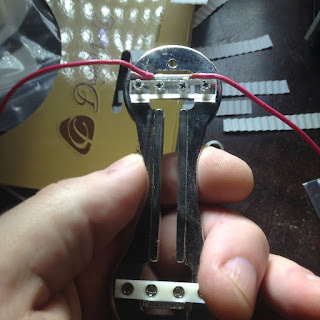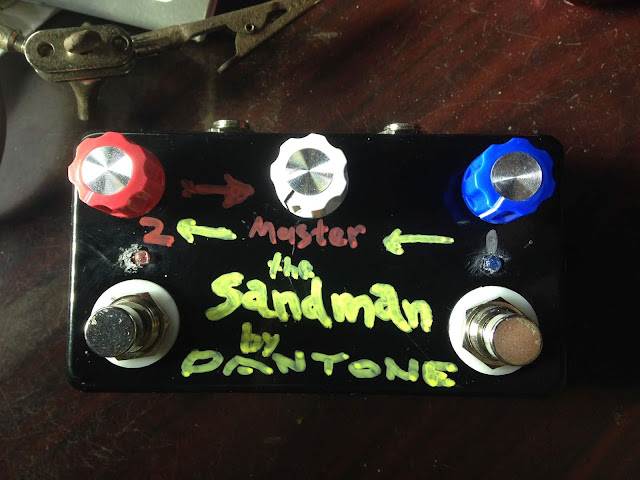INITIAL MODS
Next you can take the mic apart and remove some of the fine mesh screen with pliers, and remove the resonator plate that's on top of the ribbon motor. This is well documented on other blogs and I didn't take any pictures.
My important distinction from other modders is I left these with a 2-layer headbasket. I wanted just that little bit extra of wind protection. When you get the 1.8 micron ribbon in there, it will bend and move with the slightest breath of air or move of the mic. I would not be comfortable using this mic with a single layer headbasket. That was my judgement anyway. Look at any AEA, Coles, etc and you will see that a little bit of headbasket is just fine.
Removing all these acoustic layers cleans up the sound of the mic quite a bit. The heavy mid hump clears up a bit and the top gets more open, you can hear this well at this blog along with his instruction guide for the mod:
http://www.hometracked.com/2007/08/17/ribbon-mic-mod-part-1-apex-205/
http://www.hometracked.com/2007/08/18/ribbon-mic-mod-part-2-before-and-after/
At this point the mic has shaped up quite a bit from how it was shipped from the factory. But there's more to be done to make it compete with more expensive mics.
ADVANCED MODS - REPLACING THE RIBBON
That was the easy part! These mics come with very thick 6 micron ribbons, despite what any of the Apex spec sheets might claim. I held up my Apex 6 micron ribbon next to some 1.8u foil and with a slight blow, the difference was obvious. Michael Joly made a little video with a pencil to show this to the internet, so I had to try it myself.
I ordered my 1.8u foil and my Tube Wringer corrugator from a seller called Geistnote. He sells on ebay but also has a store you can find on google.
Watching his demonstration video really helped me a lot, I would recommend it.
I got a ruler and a cutting mat from Wal Mart. You also need a razor blade, some tweezers, a screwdriver, and some needle nose pliers, as well as a soldering iron, some scissors, etc.
My first attemps with this DIY jig were a complete failure:
So I took a few days off and got the Tube Wringer from Geistnote, along with some more foil. The main thing that's way better about it are the gears are more perfectly aligned, and much wider surface area.
My DIY Jig ribbons were coming out all crooked, which is bad. The corrugations need to go on straight and symmetrical, otherwise the ribbon will hang at weird angles in the magnet gap. This is possible also to go wrong with the Tube Wringer but it has been quite a bit more consistent in my use, with proper and ideal technique.
Also I learned that a piece of plain white paper is absolutely necessary for the way I work. It helps to stabilize the aluminum as it feeds through the gears, and protects it from rips and tears. Geistnote suggests even doubling up the paper. Really I would suggest to take a look at his short video.
You just fold the paper in half, cut a piece of ribbon, and carefully place it in the bottom of the "V." Now you are ready to corrugate. Don't squeeze too hard you can rip the paper and the aluminum. Chances are if it's your first try a few of your attemps are going to come out wrong. Don't settle for any that have obvious flaws, it's better to get it just right.
By the third or fourth time with the folded paper, and the Tube Wringer, I was getting some nice ribbons. I'm sure you could improve at this skill with more practice.
I would recommend to cut the aluminum about 1mm or so smaller than your actual magnet gap. You want probably less than 1mm of a gap on each side.
I used a ruler, the cutting mat, and a simple razor blade to make the cuts. That was the easy part of the ribbon job. The corrugating seemed to be the hardest part with the most room for error.
After you've got a nicely corrugated length of ribbon, give it a gentle stretch a few times, just like they used to do at RCA and BBC. This will keep it from sagging over time, like so many Chinese stock ribbons. Don't pull so hard you take out the corrugations, just a gentle exercise.
I found it absolutely necessary to completely remove the ribbon motor from the microphone to be able to work with the ribbon.
DO NOT attempt to desolder the red wires on the top of the motor, or you will end up with this awful situation:
There's a lot of heavy silver bearing solder and those fat wires are really on there. You're going to end up melting the plastic piece. I was able to recreate the plastic piece with some plexiglas I had in stock so lucky me. But it would be better to avoid my mistake, here's afterwards:
Now desolder the red and black wires from the PCB with the transformer on it. This is the right way to get the ribbon motor free. You should end up with something like this. Now you'll be able to maneuver that gossamer strand of aluminum into the gap where it belongs.
You have a nice opportunity to clean up any debris that might be stuck to the motor here. I used some tape to get off the tiny things that were on it. And some tweezers for a bigger chunk of something. You definitely want the cleanest possible gap between the magnets.
Hold your breath, breathe away from the aluminum. I had to take some breathing breaks actually. This stuff is LIVE when it comes to air movement.
Now carefully grab your ribbon. Just lay it in there, see if it fits, see if it's straight. If it looks good go ahead and drop the clamp on one end. Give a little tension on the other and and drop the other clamp. Use tweezers, toothpick, etc to get it to where it's just barely hanging straight with no sag. Tighten one end. Check tension, tighten the other end. This is the fiddly part, this is the expert part. It's not a particularly easy, or fun job, but it feels great if you can pull it off.
Be wary of any metal tools or debris jumping right onto the magnet and ripping your ribbon into trash. Wooden toothpick is a decent tool for working close to the magnets. My tweezers seemed OK when kept on the far ends of the motor. You could use some plastic clips maybe. Just be patient and careful with those tiny nuts when tightening them down. Don't drop them on the ribbon. I ruined at least one good ribbon with mistakes like these.
If it looks great, trim off any excess. Here's my two motors.


At this point you are ready for reassembly and testing.
You can twist the red and black wires on the bottom, left side red/black, right side red/black. But solder red with red and black with black to the transformer. Michael Joly says this can reduce hum pickup but I heard absolutely no difference in the noise floor in my room. Hmm. Michael also suggests to keep the red wires on the same plane as the ribbon and as straight as possible. Maybe you could tape them in place or something. I found the wires not to twist very well in my mic, they are different gauges. But I did it anyway, even though it looks crappy.
One of my motors had a more significant gap on one side, almost a full millimeter between the ribbon and magnet. The other one was a little closer fit. I was unsure if it would make a big difference, so I just went with it to see what would happen. When I listened to the mics back to back on voice and guitar I could tell that both mics sounded almost identical, so everything was fine! Got them both right on the first proper try, no retensioning or re-ribboning needed. I would not be able to tell these apart in a blind A/B test. Also the sensitivity was almost identical between both mics. So do a good clean job, reasonably precise, but don't get obsessed over tiny geometries. These are crude, yet precise, machines of music.
On reassembly, one of my mics had a flipped polarity. So I exchanged the red and blue (pin 2 and 3) wires on the XLR side of the PCB to get a positive polarity on that mic. The test I used was to say "PAHHHH" really loud and quickly and zoom in on the waveform in my DAW to see a rising wave on the first P transient. The out of polarity mic had a negative/downward wave on the transient. You absolutely must use a pop screen with these mics anywhere near a vocal. Possibly even on a loud cabinet or other gusty instruments.


TRANSFORMER REPLACEMENT
The final thing I'll get around to is a simple transformer replacement. I'm going to go with the Lundahl 2912 amorphous strip core transformers because I really love what I heard from Dr.Bill's piano vs the Coles on Gearslutz. https://www.gearslutz.com/board/gear-shoot-outs-sound-file-comparisons-audio-tests/150891-ribbon-madness-some-comparisons.html
My plan for these 205s is they will be my "high fidelity" ribbons with very flat response and clear sound, so the Lundahl 2912 seems like the right choice. I can't wait to find someone with an acoustic piano. I wish I knew someone personally with AEA R84s for a shootout, I think these are in that general direction.
My MXL R40 and R80 will be my character ribbon mics, for drum room and amps and whatnot, along with possibly a Cascade Fathead BE down the line. Maybe someday I'll get a Royer.
In the mean time these 205s really tickle my fancy. There is something about the way they capture the top end that is just beautiful to me. The re-ribbon is a night and day difference from the stock 6u ribbon sound, much more clear and open, better detail capture. Stock transformers seem OK but I want to see what those Lundahl's can do.
Just a little top end shelf on acoustic guitar and these are bright as anything.
Have not tried them on drums yet but that will be a fun test. I am waiting for my second shockmount.
On vocals I would suggest about a foot of distance or so, too close gets too boomy with this mic. Do not forget that pop screen, not even for a minute. You learn to respect the 1.8u aluminum after working with it. Avoid phantom power. This is all common ribbon knowledge, but should be mentioned.
I can already tell these are some mics that I'm going to be passionate about, I expect them to be favored for lots of situations. I highly recommend taking on this project if you think you have the patience and detail commitment for the somewhat steep learning curve. It took me 5 years to work up the courage but I'm glad I finally did it. Also check out www.frontendaudio.com as a good source for these mics. Get on their email list for occasional 15% off coupon codes! No affiliation they have just been really good to me. The Apex 205 would be recommended over the 210 type because the smaller body and head have less acoustic effects and ringing (thanks to Michael Joly for the observation). You end up with something a little bit like the ShinyBox product. That would be a fun shootout, too. I do think these mics sound $400 good, or so. Very impressive DIY project. From el cheapo to elegant chappo. Highly recommended!!







































